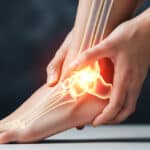
Sacroiliac joints, commonly known as SI joints are there in your lower back. They sit properly on each side of your spine. Their main function is to carry the weight of your upper body during the time you stand, walk or push loads to your legs.
Since your SI joints consist of many nerves, it will cause you significant pain if they get damaged or lose mobility. Regular wear and tear and arthritis can impact the joints by affecting their normal movement. Contact a pain clinic at the earliest if you’re experiencing debilitating SI joint pain.
Few causes of physical discomfort are worse than those related to the bones and muscles in the lower back. It is more particularly true for lower back pain originating in the sacroiliac joint. It can radiate upward from the upper thigh to the buttocks and down to your knees, causing a stabbing pain.
It may lead to aching or numbness in the pelvic muscles. You will find this fact hard to believe, but the SI joint is behind 15 to 30% of all cases of lower back pain that is acute or chronic. Talking to a back doctor to learn more about it is essential.
Sacroiliac syndrome: What can you do about it? Everything that you have to know can be found in this article.
What are the Symptoms?
- A sharp pain that starts at your SI joints and slowly moves towards your buttock, thighs, and upper back.
- Pain in one side of your lower back.
- Sign of pain while standing up.
- SI joint pain often bothers you more in the morning and gets better during the day.
- Sacroiliac joint pain is most commonly felt in the low back and buttocks but can also be referred into the thigh and leg.
Where is the Joint Located?
The essentials are listed below: It is found at the intersection of the sacrum is a triangle-shaped bone at the spine bottom. The sacrum is a flat bone with three corners on each side, located near the lower back of the hips. The ilium is the uppermost of your three hip bones. These joints are situated in your upper back.
The SI joints are made to provide shock absorption for your body and relieve pressure on the pelvis. These points are the points where your upper and lower body connect. Minimal movement was observed in the joints, according to the anatomic study. These ligaments and muscles add to the overall flexibility of the area, making it more mobile.
Do You Suffer From SI Joint Pain?
Ankylosing Spondylitis
When it hits the spinal vertebra and articulations, it is called ankylosing spondylitis. You are likely to experience ankylosing spondylitis if your SI joints, as well as other joints, lead to pain around the eyes and the whole body. An ache due to AS typically consists of intermittent pain, yet the symptoms can last a long time.
Osteoarthritis
Although arthritis often has an age distribution, Osteoarthritis is more often related to aging. The onset of osteoarthritis of the SI joint, the spine, and other joints are associated with it.
Pregnancy
Pregnancy is a commonly recognized cause of sacroiliac joint pain. This is required to widen the pelvis so that the baby can come through the birth canal. Stiffness in joints is minimized due to the mother’s lower weight, and the increased baby’s weight causes pain in her back. The pain often disappears with delivery, but for others, it may continue after the child is born due to joint instability.
Symptoms of Psychological Trauma
It can be caused by any physical injury, including pelvic pain. The effect of any automobile accident falls or some other sort of serious trauma may occur within a day or for a short period of time afterward.
Anterior Lumbar Decompression/Fusion
Even after they have had a laminectomy or a lumbar fusion, the usual body functions of the patient may change. Ordinary steel often has a much greater bone strength than the hardware used in specialty orthopedic implants. To enable the fusion of the upper and lower coils, the kinetic energy is applied below the lower coil. At the end of the trail, the final obstacle is the SI joint. Tension will lead to extra wear and tear and increased instability of the joint, causing both weakness.
How to Find Sacroiliac Joint Pain Relief?
There are various treatment options when it comes to finding relief from SI joint pain. But the first step is to stop doing things that hurt you. When you are in Oklahoma, you can visit a pain clinic and consult your doctor regarding the same. Your doctor may prescribe you painkillers during your first visit. Here are some of the other treatments that can make you feel better:
Physical Therapy
There’s no alternative to exercise. It can improve your strength and make you more gentle and flexible. The therapist will help you correct the habits that you may have picked up while trying to avoid pain.
Shots
In order to cut the inflammation, your doctor may prescribe you a shot of cortisone in your joint. If it proves to be no good, the pain specialist may numb the surrounding nerves in your SI joint to provide you relief.
Surgery
There are certain rare cases where these treatments may not provide you relief. Surgery is the only option available during this time. A surgeon will conduct an operation called SI joint fusion to join the bones near the joints.
Find a Pain Clinic
Whether it’s your sacroiliac joints or some other parts that are causing you back pain, you should visit Oklahoma Spine & Pain Management. Our pain specialists will find out the root cause of your pain, thereby helping you with the right sacroiliac treatment plan. Contact us today.
**Disclaimer: This content should not be considered medical advice and does not imply a doctor-patient relationship.






